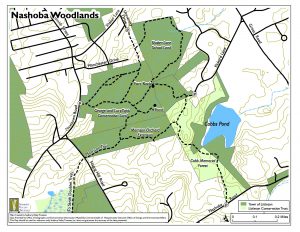Nagog Hill Orchard
Overview
83 acres that include the orchard and buildings (with the exception of the house formerly owned by Mrs. Morrison) are leased to Nagog Hill Fruiters. The remaining acreage is conservation land split between two parcels (note that the orchard is restricted – it is not land that is open for the public’s use):
The Nagog Hill Road parcel is the area below the former Morrsion home and the small orchard. This is a southeasterly facing slope that has been mowed for many years. It is bounded by Nagog Hill Road to the east; Mrs. Morrison’s lot to the north, west is the tree line, and a small apple orchard to the south. Along the road frontage there is a stone wall with red oaks and poison ivy. The slope has an even, gentle grade and is covered primarily with grasses. The grasses are invaded with violets, hawkweed, crow’s foot, everlasting and mullein. The tree line includes red pasture juniper, red maple, black birch; walnut, rose, wild strawberry, blueberry, barberry, rattlesnake plantain, poison ivy and rhododendron.
A second parcel (Nashoba Road) is a wooded slope across from the entrance to Sarah Doublet Forest. This is a west facing slope with a wet swale along the road frontage. A stone wall bisects the wooded area. Trees include hemlock, elm, white birch, black birch, hickory, red maple, white pine, red oak and beech. The under story growth is dominated by saplings of the tree cover. Shrubs observed are raspberry, blackberry, poison ivy (covering many of the trees), bittersweet (several large growths covering the trees), honeysuckle, barberry, dogwood and rose. Herbaceous layer shows horsetails, skunk cabbage, sensitive fern, cinnamon fem, lady fem, poison ivy and Canada mayflower. This larger parcel is exceptionally important, as it provides habitat and a safe migration corridor for the diverse mammal population. This wooded parcel, which is threaded by numerous small drainages from the orchard, is itself a vibrant and valuable “edge”‘ habitat, because it is bordered on one side by orchard. A connector trail starts from Nashoba Road across the road from the Sarah Doublet Forest Road and passes through the parcel to Nagog Hill Road and then connects to the blue dot trail on the detached parcel.
The Town has designated Nashoba Road and Nagog Hill Road as scenic roads because of the spectacular views and natural character of the area. The property had been beautifully cared for over the years by the Morrison family, whose adoption of integrated pest management in their orchard operations has further protected the ecological value of the site.
The site has a rich geological history, with many interesting glacial landmarks. Is it a local epicenter for earthquakes, a fact well-documented in Native American cultural history of the region. The Nagog Hill Orchard is the last remaining commercial apple orchard in Littleton. Apples have been central to Littleton’s identity, with apple blossoms at the center of the Town’s seal. Nagog Hill Farm is at Littleton’s heart, in terms of its incredible beauty, bountiful harvest, watershed protection, and enlargement of adjacent conservation lands.
Trails
The Blue Dot trail passes through a detached, Town-owned 24 acre parcel. This rectangular- shaped land is located on the east side of Nagog Hill Road. It is bounded on three sides by stone walls. The land consists of woodland, small swamps, intermittent and permanent brooks, springs, vernal ponds, bedrock outcrops, and large boulders. The trail follows the old road from Nagog Hill Road, near the south side of the property, for about 2000 feet. The last 200 feet proceeds through the woodland to the stone wall boundary. Here it connects to the Cobb Memorial Footpath (for more information, see the section on the Robert and Emily Cobb Memorial Trail).
At the parking area off Nagog Hill Road is access to the Dr. Ed Bell Trail, indicated by blue markers. For more information about this trail, see the description of the Sarah Doublet Forest.
Directions
Off Nagog Hill Road, across from Lake Nagog. The parking area is surrounded by split-rail fence. There is space for seven cars. The Dr. Ed Bell trail starts here and enters Sarah Doublet Forest.


